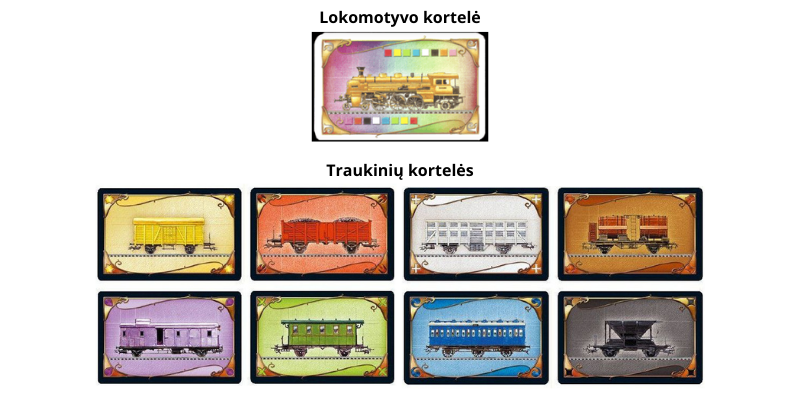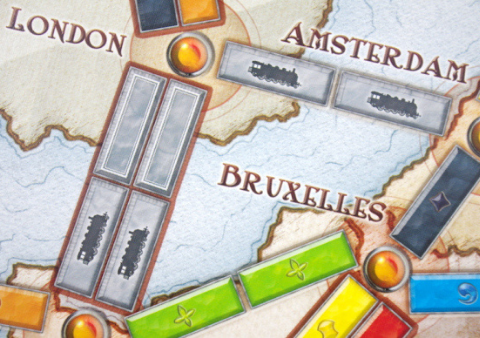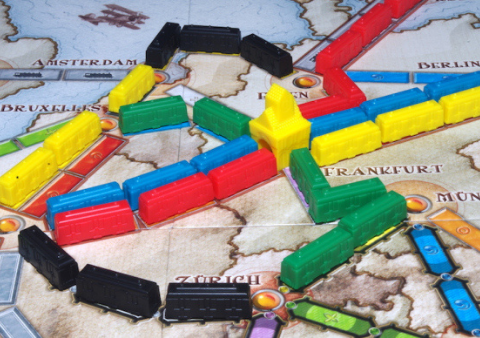Love to travel? Always been fascinated by train travel? Ticket to ride is the perfect game to help you visit Europe's biggest cities. The action takes place between 1890 and 1910. So you'll not only be travelling across Europe, but also back in time to when our grandparents or great-grandparents were still living on earth.

Other games for two
Sometimes it's just the two of you at home and you don't have the opportunity to invite friends over. In this case, choose games that only need two players. If you've already tried Ticket to ride, the next step is Codenames Game. In this game, you will become a scout and commander of secret agents. In this case, you will be one team and you will have to defeat an imaginary enemy. How is this possible? Simply by having the Secret Agent Commander draw the cards for your opponent.
Ticket to ride rules and game description
The aim of the game - score as many points as possible. To get more points, do the following:
- A busy route connecting two neighbouring cities;
- Completion of the travel objectives - a continuous path is built between the cities on the card (if the travel objective is not completed, the card's point value is deducted at the end of the game);
- The longest continuous route and a European Express card (train stations do not count towards the longest route);
- When there are unused train stations at the end of the game.
The game set includes:
- Map of Europe;
- 240 train carriages (blue, red, green, yellow and black);
- 110 train cards, 14 of which are locomotives;
- 40 regular route cards;
- 6 long-route cards,
- 1 European Express card, awarded to the player who completes the longest continuous journey;
- 1 scorecard;
- 5 wooden tokens;
- 15 colourful train stations;
- 1 booklet containing the Ticket to ride rules.
Number of players: 2-5 people.
Game duration: 30-60 min.
Age of players: 8+.
Frequently asked questions
❓ How many people can play Ticket to ride?
According to the Ticket to ride Europe rules, you can play from 2 to 5 people.
❓ How old can I play Ticket to ride Europe?
According to the official rules, the minimum age for Ticket to ride players is 8 years. Of course, younger children can play it too, as long as they are able and interested.
❓ How long does it take to play one game of Ticket to ride?
The duration of the game varies from 30 to 60 minutes.
Preparing for the game
1. Game board and pieces
A game board is placed in the middle of the table. Players choose their colour and take 45 train cars, 3 train stations and one wooden token. Only the pieces of the chosen colour need to be taken.
2. Preparing for scoring
All players' wooden chips are placed on the scoring board in the starting box. The points are written on the game board around the map of Europe in a clockwise direction. The official Ticket to ride rules state that points are to be counted after every move that scores at least one point. By convention, all points can be counted at the end of the game to keep the game intriguing, as no one will know who is ahead or how far ahead.
3 Train cards
The train cards are shuffled and each player is dealt 4. The remaining cards are placed face down next to the game board. Then 5 cards are taken from the top and placed face up next to each other.
4. European Express card
It is placed open next to the game board so that players can see the incentive for building the longest path at all times.
5. Long journey cards
The first distinction to be made is between long-distance travel routes. There are 6 of them. They differ from the regular route cards by the background colour blue. These cards are shuffled and dealt to all players, 1 each. The remaining Long Route cards are placed in the game box and will not be used. They must not be looked at so that nobody knows which route is free.
6. Regular travel route cards
They differ from the long-distance routes in that the background is black and white. These cards are shuffled and 3 are dealt to each player. The remaining cards are placed face down in a pile next to the game board.
Ticket to ride game launches
First, players look at the Goal Cards they have and choose which ones they will try to complete. It is possible to keep all the cards, it is possible to give something away. Choosing a good Strategy, we may be able to meet the targets for all available routes. At least 2 cards must be retained. You cannot change your mind during the game, so cards that are retained cannot be returned later. If a player does not want to follow certain routes, he/she must place the cards in the game box in such a way that others cannot see their contents. Those cards will no longer be part of the game. Both regular and long routes can be refused.
Game moves
The player who has visited the most European countries starts the game. If the same people are playing all the time, it becomes uninteresting, so there is another way to choose the starter: in a bag, jar or somewhere similar, we put 1 wagon piece per player. Then someone pulls one out without looking. Whoever has that piece starts. Ticket to ride then continues in a clockwise direction. Only 1 of the following actions can be performed during your turn:
- Pull-out train cards - draw two train cards from the face-down pile or take two face-up train cards. Exception for face-up locomotive card - only one can be taken.
- Occupied route - the player must hand over as many cards of the corresponding suit as the length of the route. After the cards have been dealt, the player places one train carriage of his colour on each of the boxes on that route. The number of points awarded is the number on the scoring card.
- Destination tickets are pull-out tickets - If you want more of a challenge, you can draw 3 destination tickets. After viewing them, you must keep at least one.
- Building a train station - it can be built in any city that doesn't already have one. It is important to remember that when building your first station, you need to hand in one train card. For the second station, 2 cards of the same colour. For the third station, you will need three train cards of the same colour.
Drawing train cards
There are 8 colours of train cards in total. 12 of each colour. There are also 14 locomotive cards. The colour of the card corresponds to the colours of the routes on the board: purple, blue, orange, white, green, yellow, black, red.
A player can draw two train cards in one turn. They can be drawn either by selecting the desired cards from the five train cards face-up or by blind drawing from the face-down pile. When at least one card is taken face up, another card must be immediately placed in its place (taken from the top of the face-down pile). When a face-up stack is taken locomotive card, then the second card can no longer be taken.
If 3 locomotive cards appear in the 5 cards face up, then all 5 cards must be placed immediately in the used cards pile.
You can hold as many cards as you like. If the stack of cards is exhausted, the used cards are shuffled and used again in the game. The shuffling must be done very carefully so that many cards of the same colour are not left next to each other.
If the stack of cards runs out and there are no more removed cards because they are all in the players' hands, the Ticket to ride game is not over. In this case, one of the remaining actions must be taken during your turn: take a route, build a station or draw destination tickets.

Locomotives
Locomotives in this game are versatile. They match any other colour of card. So if there is a shortage of cards of the same colour when taking a route, locomotives can be used instead. In addition, without locomotives you cannot take ferry routes. The route specifies the minimum number of locomotives.
The locomotive card can be picked up face up during the card draw. But if this is done, then no more than one other card can be taken (whether it is a regular train card or a locomotive card). If the first train card is taken and the locomotive card is turned up, it cannot be taken. The remaining train cards must be selected. Similarly, if the regular train card is taken first, the locomotive (as second card) cannot be taken either. But if the locomotive card is drawn from the face-down pile, it is counted as one and then the second can be drawn.
Route occupancy
A route is all the boxes that lie between two cities. The boxes are either a specific uniform colour or grey. Cards of a specific colour must be handed in when the route is taken. The number of cards must be the same as the number of cells on the route. If there are no cards of a specific colour, locomotives may be used instead.

Routes in grey can be occupied using the same cards of any colour.
Once the required number of cards has been allocated, one wagon is placed on each cell of that route. The points are then immediately counted on the scorecard. The wooden piece is moved forward through as many boxes as the number of points for that route. (If you have agreed to count the points after the game, do not move the piece now).

Any available routes can be occupied. They do not have to connect to routes that are already occupied. The most important thing is that the whole route is occupied in one move. It is not possible to place 2 wagons on a 4-cell route and wait for the remaining cells to be filled.

Only 1 route can be occupied per turn.
Dual routes

Dual routes can be distinguished by the fact that they are parallel, have the same number of cells and connect the same cities. One player cannot occupy both such routes. Routes which are partly parallel but connect different cities are not double.
If there are 2 or 3 players, double routes cannot be used. If one of the routes is occupied, the other is closed. When 4 or more players are playing, double routes can be used.
Ferries

The ferries differ from other routes in that they are grey in colour and at least one of their boxes shows a locomotive. They connect cities across bodies of water.
To take a ferry route, you need to hand in as many locomotive cards as the number of boxes. The remaining number of boxes can be filled by giving as many cards of the same colour as there are boxes left.
Tunnels
The tunnels differ from other routes in that the outlines of all cells are outlined in black. They require a different number of cards each time.
First, you need to place as many cards of the same colour as the length of the tunnel. Then three train cards (from the top of the face-down pile) are turned over. If the cards face up are of the same colour as those placed to occupy the tunnel (or if there are locomotives), then an additional card (or locomotive) of that colour must be surrendered for each such card in the hand. Sometimes no additional cards are needed, but there are times when the additional cards are worth the full length of the tunnel.

If a player does not have enough cards of a particular suit in his hand, or does not wish to use them, then he takes his cards back and ends his turn.
At the end of the turn, remove all three train cards face up.
If a player wants to use the locomotive cards to pass through the tunnel, then he will only need to hand over additional cards if he opens the locomotive card.
If there are no more or not enough train cards available, then the player will only turn over as many cards as are left to occupy the tunnel.

Drawing tickets for your destination

During his turn, a player can draw 3 Goal Tickets. These must be taken from the top of the face-down pile of cards. If there are no more than 3 cards left, the number of cards remaining must be taken.
It is essential to keep at least one of the cards after viewing them. You can also take all three if it is possible to complete the routes. Cards that are not wanted are placed at the bottom of the discard pile. The player must keep the cards kept until the end of the game. They may not be handed in afterwards.
Destination cards give either extra points or penalty points. If, at the end of the game, the player has built continuous roads between the cities indicated on the card, he receives the number of points indicated on the card. If the player fails to connect the cities, the number of points on the card is deducted from the player's score.
You can take as many destination tickets as you like. They cannot be shown to other players until after the Ticket to ride game has finished and the points are counted.
Building train stations

A train station allows you to cross (take a competitor's train) on any one route in order to connect the cities listed on your destination ticket. The path connected by the station is not included in the calculation of the longest route. A station may be built in any empty city. Only one player can have a station in a city.
A station can be built even if there is no route to that city yet, but it will only become operational when someone builds their own trains on the road.

Only one station can be built per turn. Three stations can be built in the whole game.
To build the first station, the player surrenders one of any train cards and places his station piece on the desired city. For the second station, two cards of the same suit must be surrendered. For the third station, three cards of the same suit must be surrendered. If there are not enough cards of the same colour, they can be replaced by locomotive cards.
Stations are optional. At the end of the game, the player receives 4 points for each unused station.
Ticket to ride game ends
When a player has 2 or fewer wagons left on his turn, then he and everyone else is allowed to make only one turn and Game is completed.
Scoring
Unless otherwise agreed, points for occupied routes are counted throughout the game. They can be recalculated after the game if desired to avoid errors.
All destination tickets are then shown. Points for fulfilled destinations are added to the total, points for unfulfilled destinations are subtracted. The number of points is written on the destination card.
The train station only allows one route to be used by another player, so that route must be used for all destination tickets.
If a player has not used his stations, he receives 4 points for each unused station.
Count the number of cells for the longest routes for all players. The player with the longest route is given a European Express card and 10 points are added to the point total. If several players have the same length of routes, they both get 10 points. Only continuous paths of the same colour count. They can go round and round and cross the same city several times, but we do not add a second time to the already counted repeating wagon. Opposing routes that we connect with our own at stations to meet a destination do not count towards the longest path.

The winner is the player who scores the most points. In the event of a tie, the player who completes the most travel objectives wins. In the event of a tie, the winner is the person who has used the fewest stations. And if there is still a tie, the winner is the person who received the European Express card.





